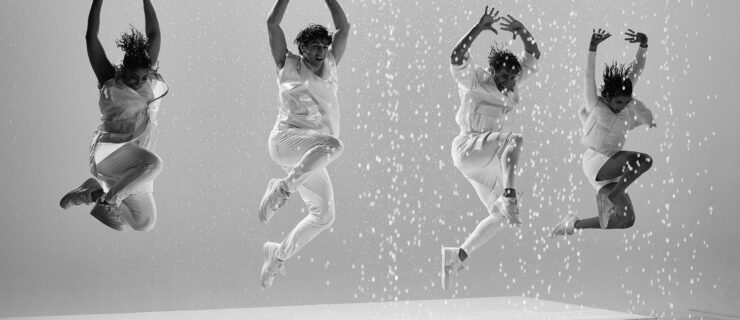Keepers of the Flame
Ross Katen auditioned for the Limón Dance Company on his 21st birthday, just after graduating from the BFA dance program at New York University’s Tisch School of the Arts. Limón, he knew, was an unusual choice for a recent NYU alum. “I’d been focused on creating new work in a pretty progressive conservatory program,” he remembers, “and this was a company performing dances that had been in repertory since the 1940s.” But after the audition and a weeklong workshop, he felt excited about the challenges of the dramatic Limón style—and he earned a contract with LDC.
For many young dancers, the performance dream centers on contemporary companies. And for good reason: Getting to perform new works and be involved in the creative process is pretty darn exciting. But dancers are also finding fulfillment in time-honored repertory groups like LDC, Paul Taylor Dance Company and the Martha Graham Dance Company—companies that were established long before they (and, in some cases, their parents) were born.
Why join a company grounded in the past? For one, Katen says, the work still resonates. Though LDC was established in 1946, “there are so many intricacies to explore within the repertory,” he says. “You can still find new ideas to play off of in historical pieces.” That quality, he says, is what’s allowed those works to stick around.

(From left) Ho, Katen and O’Donnell strike a pose (photo by Jayme Thornton)
Today, LDC primarily presents pieces by Limón himself—just as the MGDC repertory is mostly Graham, and the PTDC rep is nearly 100 percent Taylor. That means dancers get
a chance to dig deep into a single vocabulary, exploring the nuances of its technique through a wide variety of rep. “I love the diversity of Paul Taylor’s work,” says Madelyn Ho, who recently joined PTDC after spending four years in the company’s apprentice/
touring group, Taylor 2. “There are some really dark, ugly pieces that let me draw on my intense side, and there are happier dances, too. Having the opportunity to experience that range—and all by one choreographer—really pulls me in.”
Anne O’Donnell, who joined the 90-year-old MGDC as an apprentice
in 2014, agrees. “Working in one style so intensely is gratifying,” she says. Classic techniques like Graham are also a great foundation to build a career on, because “so many choreographers have come out of the traditions of these modern dance pioneers,” O’Donnell says.
Because their names are well known throughout the world, classic modern companies tend to tour frequently, too. MGDC tours internationally several months out of the year; PTDC travels 16 weeks each year. O’Donnell loves that her job lets her see the world. “Touring has been one of the biggest blessings,” she says. “One of my proudest career moments was going to Sweden with MGDC to learn a new work by Mats Ek. It was surreal.”
Now is an especially good time for younger dancers to look into older companies. In the past, heritage modern groups have struggled with funding, which has sometimes meant limited seasons. But recently, there’s been an exciting wave of revitalization. Last October, to celebrate Limón’s 70th anniversary, companies from around the globe gathered at The Joyce Theater in NYC to perform a wide variety of Limón’s work. MGDC has commissioned work from contemporary choreographers, including Kyle Abraham, Sonya Tayeh, Nacho Duato and Andonis Foniadakis. And last year, Paul Taylor—who continues to create new pieces—broadened his troupe’s scope by creating Paul Taylor’s American Modern Dance, a presenting organization that showcases guest companies and outside choreographers. (PTDC also presents a jam-packed month-long season at Lincoln Center each year.)
Above all, joining a classic modern company offers young dancers a chance to participate in a revered, time-honored tradition. “You feel like you’re part of a bigger history,” Ho says. “When you put on a Taylor costume, you know there have been all these dancers who’ve worn the same one before you. It’s a pretty amazing feeling.”

(photo by Jayme Thornton)
Madelyn Ho, Paul Taylor Dance Company
What she loves about Paul Taylor’s work:
“Connecting with people onstage. You get to make eye contact and be a human instead of a ‘performer.’ ”
Advice for
DS readers: “Think about how to dance with others. When I was younger, I lacked spatial awareness and was too focused on technique.”
Number-one PTDC audition tip:
“Taylor’s auditions start out with just walking across the floor alone. It’s terrifying. But don’t let it psych you out. They just want to see you being yourself.”

(photo by Jayme Thornton)
Ross Katen, Limón Dance Company
What he loves about Limón’s work:
“Limón was a master of theatricality, but he has such a huge range. For example, The Winged is totally abstract. There’s also a certain morbidity to much of his work that I find fascinating.”
Advice for
DS readers: “Remember that dance is subjective. It’s dependent on who’s viewing it, and on which day, and where. That’s good, though: As a dancer, it’s important to be open to different opinions.”
Number-one Limón audition tip:
“Rhythm is one of the most important elements of Limón technique and choreography. You have to be a musical dancer.”

(photo by Jayme Thornton)
Anne O’Donnell, Martha Graham Dance Company
What she loves about Martha Graham’s work:
“It’s so honest, so true. It shows off the body and makes you a powerful performer.”
Advice for
DS readers: “Know that hard work does pay off. Dance isn’t an easy career; at some point you’ll question why you’re doing what you’re doing. But believe in yourself—and be kind.”
Number-one Graham audition tip:
“Know the foundation of the technique, and look the part. Wear skin-tight clothing that shows off your body and your contraction. Show your knowledge of the company.”




